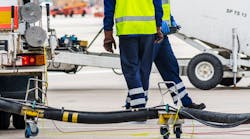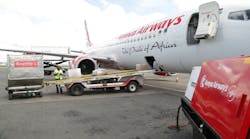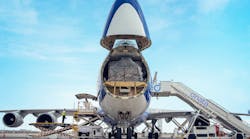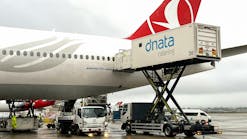How Australia’s Population Distribution Influences Ground Handling
Australia has a sophisticated aircraft ground handling infrastructure that caters well to a growing aviation industry. One of the distinctive features of Australia is that the country is very large by size but it only has a population of around 25 million people. Most of the land located in the middle of Australia is baron and desert like, so most of the population resides along the coastline, where all the major cities are located.
Indeed there is a large divide between the availability and provision of ground handling services between the major airports and the Australian outback.
“The airports of the major cities all have one or more players offering ground handling services, while only the more remote locations have possibly only a single player. It is often Australia’s national carrier – Qantas – that offers ground handling services at the more remote locations. These airports just do not get enough traffic to enable many players,” says Derek O’Reilly, managing director of Universal Aviation Australia.
“The ground handling infrastructure in Australia is part of a mature industry that has developed alongside the increase in traffic volumes. Major and regional airport handling companies have adapted and expanded over the years, most recently with the arrival of the A380 into markets such as Brisbane, and the huge increase of flights as a result of low-cost carriers such as Virgin and Jetstar,” adds Gary Forster, regional FBO manager, ExecuJet Asia-Pacific.
Since the economic outlook is positive and Australia offers a growth potential, earlier in the year ExecuJet expanded its presence in Sydney, New South Wales, with the acquisition of an FBO to complement its existing maintenance, flight operations and administration facility.
The recently renovated FBO is located at Sydney’s Kingsford-Smith Airport, which is 12km from the city center, and consists of a dedicated VIP guest lounge, passenger amenities and private meeting rooms for guests in transit as well as customs and immigration processing facilities. The FBO employs 20 staff members including management, ramp coordinators, customer service agents and administration staff.
The case of ExecuJet is noteworthy also because this year has marked the 10th anniversary of operations in Melbourne, Victoria.
ExecuJet Melbourne offers MRO, FBO and aircraft operations services. The MRO houses a 2,700 m² facility, workshops and stores, supporting Melbourne-based and visiting aircraft. In 2011, ExecuJet expanded its services to include an FBO, providing passengers with VIP services and amenities from a dedicated, purpose-built VIP lounge.
ExecuJet’s Melbourne MRO holds an Australian CASA Certificate of Approval, New Zealand CAA approval and is an FAA Part 145 Repair Station, enabling the company to work on a wide range of business jets, turboprops and light aircraft. The facility is also an Authorized Service Center for Hawker Beechcraft, Gulfstream, Bombardier and Embraer.
Even if the market for aircraft ground handling services is healthy, there are also some operational challenges for ground handling companies in Australia.
“Several Australian airports, for example, have curfews, which dictate when an aircraft can arrive and depart, due to the airports being located quite close to residential areas. The more remote locations also have runway length restrictions, which eliminate certain aircraft traveling to those locations,” says O’Reilly. “In addition, staff costs are extremely high in Australia, so many of the locations would hire casual staff to assist with operational duties, rather than having full-time staff.
“Staff costs are also a result of charges for services being higher - compared to the US, for example. On the contrary, the level of service in Australia is quite high, the staffs are well trained and our safety standards are very high.”
“The sheer volume of passengers now travelling domestically and internationally has grown rapidly, with almost all airports showing increasing numbers. This has meant the ground handlers have had to expand to cope with increasing flights and aircraft sizes,” adds Forster.
“In addition to this, new equipment purchases have become vital to keep up with the latest aircraft, such as A380, B787 and A350. With the increased number of travelers, many new airlines have started with previously rare equipment in the region such as BAe146, Saab 340, E190, ATR etc., which has posed equipment challenges for the ground handlers,” he says. “The ground handling is dominated by a handful of players such as Qantas, Menzies and dnata and could benefit from increased competition. However the start-up costs for any new company would be significant and with no guarantee of a sustainable business in a market with large labor costs.”
One of the peculiar traits of the handling business in Australia is the big divide in terms of the development of aircraft ground handling services between urbanized and peripheral areas of the region. This is due to the fact that there are very few private aircraft traveling to the remote locations of the Australian outback.
Depending on how the resource sector will perform in the years ahead, the remote locations could represent a business opportunity.
“I believe that further development will only occur in these locations when and if traffic increases. Many of the remote locations are resource driven and it could be an increase in commodities that would increase interest and traffic to these locations. This is with exception of the famous Ayers Rock, which is centrally located and it is an important tourist attraction,” concludes O’Reilly.









